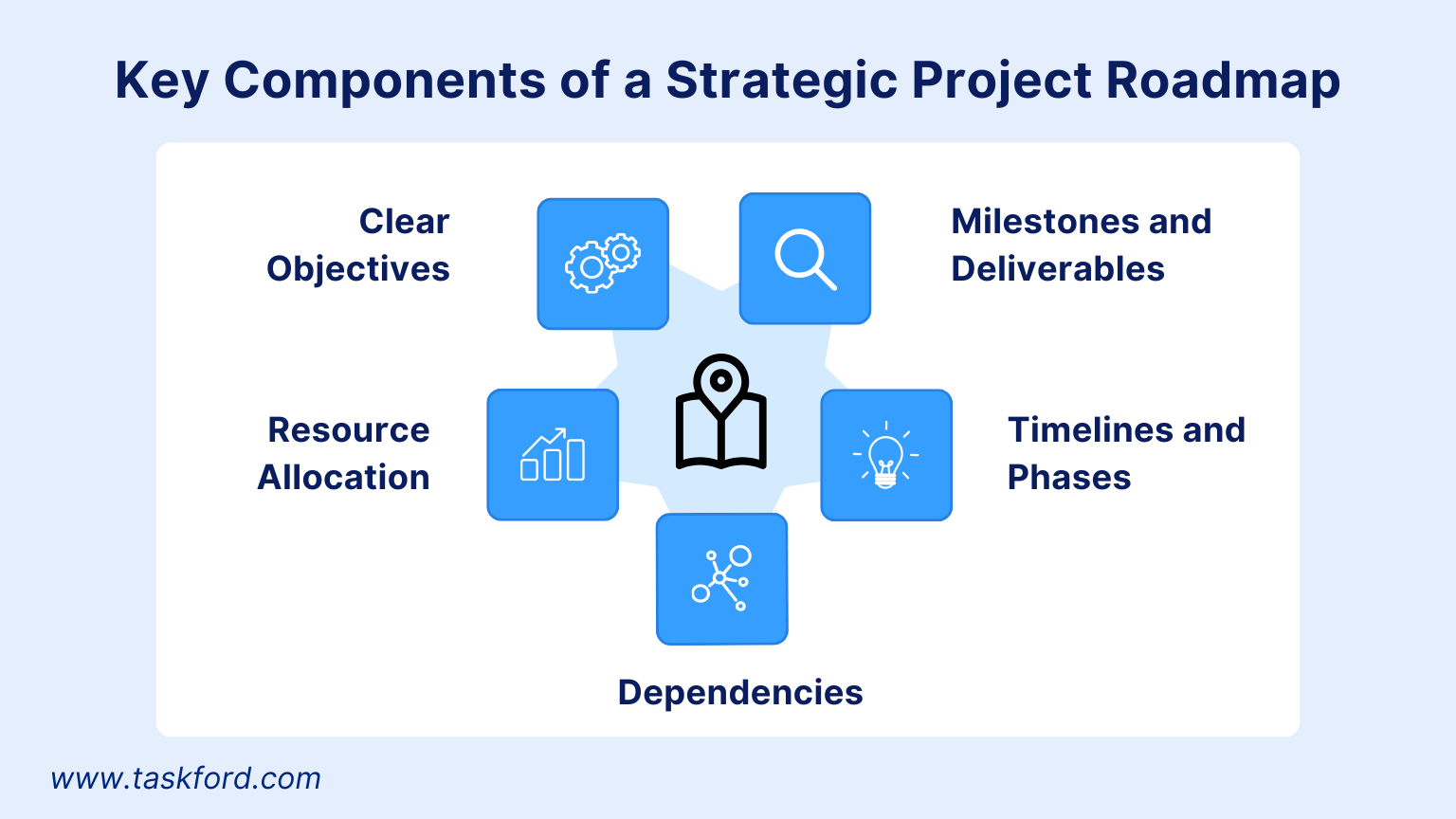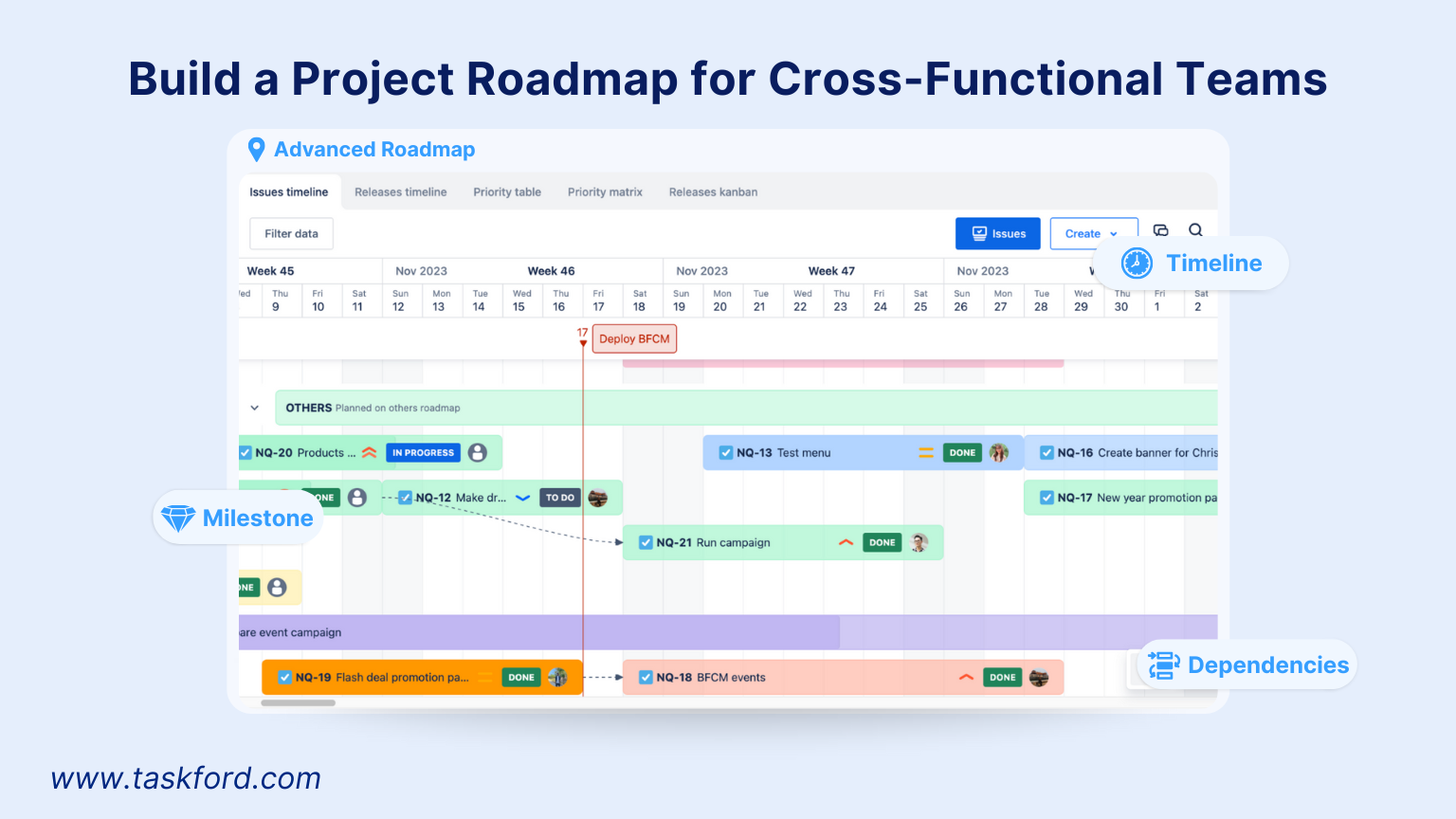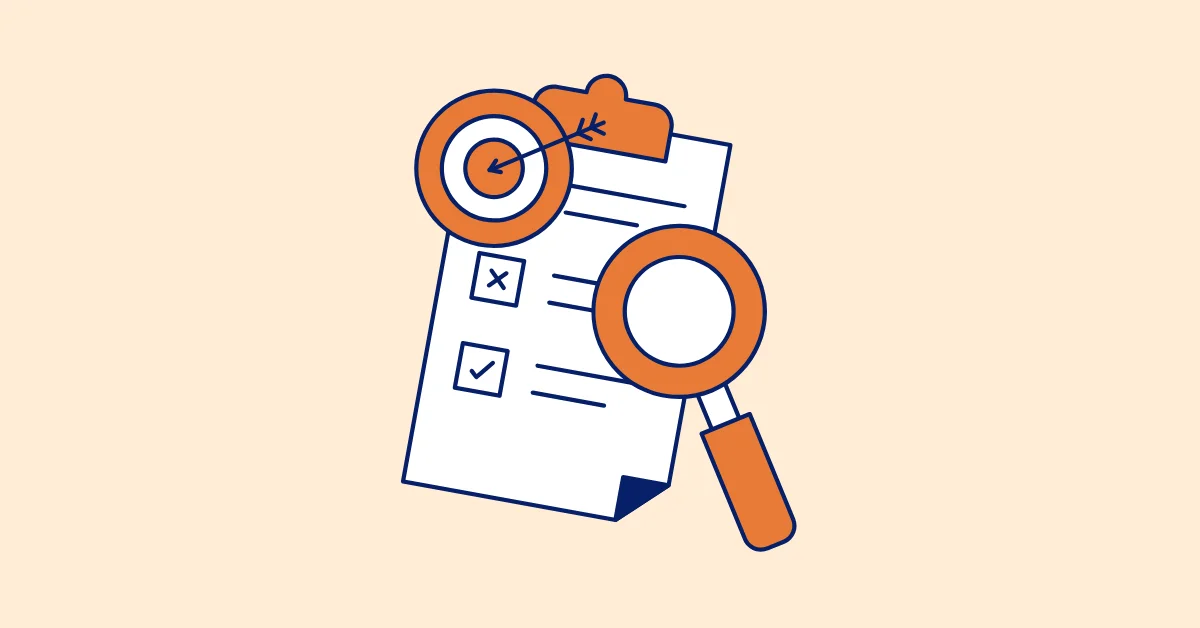Strategic Project Roadmaps: A Guide for Cross-Functional Teams
Explore what a project roadmap is, how it benefits cross-functional collaboration, and learn how to build one that keeps your entire team aligned.
In project management, clarity and alignment are essential, especially when working with cross-functional teams. A project roadmap serves as a strategic visual guide that outlines key objectives, milestones, and timelines, helping stakeholders across departments stay on the same page. Unlike task-level tools like Gantt Charts or detailed project plans, a roadmap communicates the what and why of a project, making it indispensable for high-level decision-making. In this guide, we’ll explore what a project roadmap is, how it benefits cross-functional collaboration, and how to build one that keeps your entire team aligned from kickoff to completion.
What is a Strategic Project Roadmap
A project roadmap is a high-level visual plan that outlines the key objectives, milestones, and timelines of a project. Unlike detailed task schedules or Gantt charts, a roadmap focuses on the big picture, communicating priorities and progress to stakeholders across departments. For cross-functional teams, comprising members from marketing, engineering, finance, and other functions, a roadmap ensures alignment by clarifying how individual contributions fit into the broader strategy.
Key Components of a Strategic Project Roadmap
A successful project roadmap includes several core elements tailored to cross-functional collaboration. These components ensure the roadmap is both comprehensive and easy to understand.

- Clear Objectives: Every roadmap should start with well-defined objectives that align with organizational goals. For example, a product launch roadmap might aim to “deliver a new feature to market by Q3 to increase user retention by 15%.” Objectives should be specific, measurable, and agreed upon by all teams.
- Milestones and Deliverables: Milestones mark significant points in the project, such as completing a prototype or securing stakeholder approval. Break these into deliverables assigned to specific teams, like “marketing completes campaign assets by Week 4” or “engineering deploys beta version by Week 8.”
- Timelines and Phases: Timelines provide a visual sequence of tasks and milestones. Divide the project into phases (e.g., planning, execution, review) to make progress manageable. For cross-functional teams, ensure timelines account for overlapping tasks across departments.
- Dependencies: Dependencies show how tasks rely on one another. For instance, marketing can’t launch a campaign until engineering completes a feature. Mapping these clearly prevents bottlenecks and keeps teams aligned.
- Resource Allocation: Identify the resources, such as people, tools, or budgets, needed for each phase. Cross-functional teams benefit from tools like TaskFord, which offers features like Resource planning to balance workloads across departments.
How Project Roadmaps Benefit Cross-Functional Teams
In organizations, projects often require contributions from multiple departments such as marketing, engineering, finance, and operations. Each team has its own priorities and workflows, which can easily lead to misalignment or conflicts over resources. This is where a project roadmap becomes invaluable:
- Creating a Shared Vision: A roadmap provides a big-picture view of objectives, timelines, and expected outcomes. This ensures that every department understands the project’s direction and how their work contributes to the overall goal.
- Aligning Priorities: Instead of each team focusing on its own isolated goals, the roadmap aligns priorities across departments. This is especially critical when resources are limited or deadlines are tight.
- Clarifying Dependencies: Many tasks can only move forward once others are completed. A roadmap makes these dependencies visible, helping teams avoid overlaps and reducing the risk of delays.
- Increasing Transparency and Accountability: With milestones and responsibilities clearly outlined, teams can easily track progress and take ownership of their deliverables.
- Facilitating Effective Communication: The roadmap acts as a “common language” across departments. Meetings and reports can be structured around the same reference point, ensuring smooth and consistent communication.
In other words, a project roadmap is not just a project management tool - it serves as the glue that binds cross-functional teams together, ensuring everyone works toward the same objectives with better coordination and efficiency. For instance, as highlighted in a Forbes article, an optimized roadmap can help detect misalignments early, such as differing definitions of "quality" among teams, enabling collaborative solutions to prevent project delays (Forbes, 2023).
How to Build a Real Strategic Project Roadmap in 7 Steps
Building a strategic project roadmap is not just about creating a timeline of tasks. It’s about aligning objectives, making informed strategic choices, and ensuring every cross-functional team works toward the same outcome. Below is a step-by-step guide to help you create a roadmap that drives clarity, alignment, and measurable results.

Step 1: Define Clear Objectives and Success Metrics
Every roadmap must begin with well-defined objectives. Use the SMART goal (Specific, Measurable, Achievable, Relevant, Time-bound) or OKRs to ensure goals are concrete.
- Example objective: “Increase customer retention by 15% in Q3” or “Acquire 20 new enterprise clients by Q4.”
- Success metrics can include: customer retention rate, adoption rate, annual recurring revenue (ARR), or time-to-value.
Quick checklist
- Objectives are specific and measurable
- Targets and timelines are clear
- Objectives are agreed upon by all teams
Step 2: Set the Context and Identify Stakeholders
Objectives without context can lead to misalignment. Document the business context, assumptions, and constraints so everyone understands the bigger picture.
Next, map out your stakeholders and their roles using a simple RACI matrix (Responsible, Accountable, Consulted, Informed). This ensures clarity on who drives what.
Quick checklist
- Context, assumptions, and risks are documented
- Stakeholders are mapped across departments
- Ownership and accountability are clear
Step 3: Generate Strategic Options (How Might We?)
Once you know the objective, brainstorm multiple ways to achieve it. Ask “How might we…?” to encourage creative thinking.
Examples: launch co-marketing campaigns, improve onboarding, expand into new regions, add system integrations, change pricing models, or recruit additional partners.
Quick checklist
- Create 5–9 potential strategies
- Outline assumptions and expected impact for each
- Identify high-risk options that may require experiments
Step 4: Evaluate and Choose Strategic Bets
Not every idea makes it into the roadmap. Use an Impact × Effort × Risk matrix to prioritize. Select 3–5 high-value bets that balance ambition with feasibility.
Example: instead of adding new products (high effort, low short-term payoff), choose to improve onboarding (medium effort, high impact).
Quick checklist
- Top 3–5 strategies selected
- Clear “will do / won’t do / investigate” list
- Experiments planned for uncertain choices
Step 5: Translate Strategy into a Roadmap Structure
Now it’s time to bring your strategy into a visual format. Choose a timeline style such as Now–Next–Later or quarterly buckets (Q1, Q2, H2). Organize the roadmap into streams (e.g., Product, Marketing, Sales, Customer Success, Operations).
Example roadmap structure:
- Q1: Discover onboarding issues, align marketing message, train sales teams
- Q2: Launch onboarding v1, start co-marketing campaign, co-sell key accounts
- H2: Expand integrations, roll out advanced campaigns, measure retention impact
Quick checklist
- Roadmap structured into timeframes
- Organized by streams or themes (not tasks)
- Outcomes highlighted, not just deliverables
Step 6: Map Dependencies, Resources, and Operating Cadence
Cross-functional projects often fail due to overlooked dependencies. Make them visible. For example, Marketing’s launch may depend on Engineering’s release date.
Also balance strategic vs. tactical work. Your team still has to handle bug fixes, customer requests, and maintenance. Allocate resources realistically.
Finally, establish an operating cadence for reviews:
- Weekly squad syncs
- Bi-weekly cross-functional updates
- Monthly roadmap reviews
- Quarterly re-planning sessions
Quick checklist
- Dependencies clearly mapped
- Resource allocation realistic across teams
- Cadence for reviews and updates established
Step 7: Communicate, Execute, and Iterate
A roadmap is not a static plan. It’s a living strategy document that should evolve as new information emerges.
- Share a one-page summary with executives and a detailed version with working teams.
- Track progress with dashboards showing milestones, KPIs, and risks.
- Maintain a change log to keep transparency when adjustments are made.
Quick checklist
- Roadmap communicated at all levels
- Dashboard tracking outcomes (not just outputs)
- Change log updated regularly
Conclusion
A well-crafted project roadmap is more than just a timeline, it’s a strategic alignment tool that drives clarity, accountability, and cohesion across cross-functional teams. Whether you're planning a product launch, leading a marketing initiative, or managing software development, the roadmap ensures every stakeholder understands the big picture. By outlining clear goals, identifying dependencies, and setting realistic timelines, you create a shared vision that supports successful project delivery.
For more detailed strategies, check out the comprehensive Project Management Guide to enhance your roadmap creation process.
Making work simpler,
smarter, and more connected
Join our waitlist and be notified first.

Related Blog
Subscribe for Expert Tips
Unlock expert insights and stay ahead with TaskFord. Sign up now to receive valuable tips, strategies, and updates directly in your inbox.






